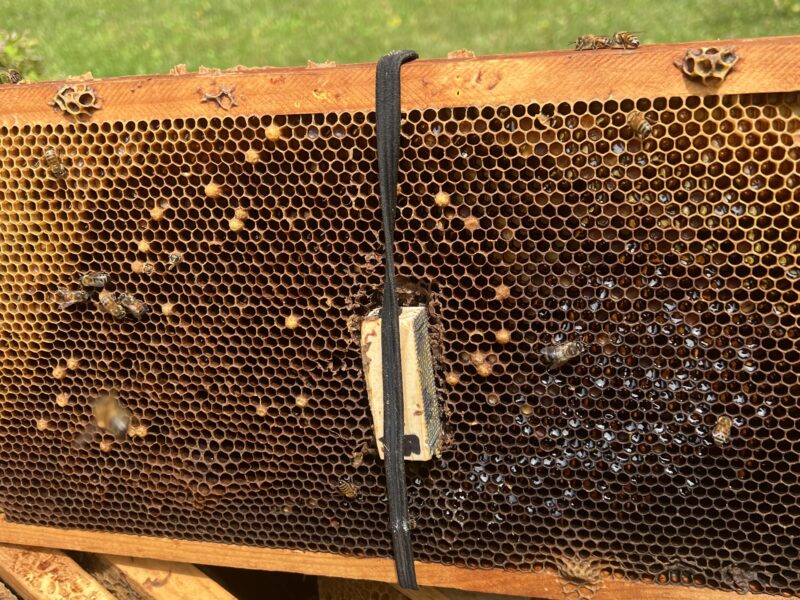

Well, this was supposed to be a column about challenges met, bee colonies saved, blah blah blah happy news. Turns out, not so much.
Last year at this time we had four thriving hives — probably a quarter of a million bees in total — working their stripes off making even more bees and gallons of honey. I was maybe feeling a little smug about it, like, “Oh yeah, I got this bee thing figured out.”
As anybody raised Catholic can tell you, feeling smug is asking for trouble. It’s inviting the universe to slap you upside the head, which of course it promptly did. We ended up going into winter with just one hive remaining, after the other three colonies moved out in the fall. But that hive went into winter strong, with plenty of honey in reserve. I took a quick peek in the spring as soon as it was warm enough, and they seemed fine. A couple of weeks later, it was warm enough for them to start flying, but they didn’t. I opened up the hive to find piles of dead bees. They had plenty of honey on hand, so I have no idea what happened. Maybe Jonestown, the honeybee version?
Undeterred, we decided to get two new colonies to start off this year, thinking we might be able to split those and get back to having four working hives by mid-summer. We picked up the first nuc in April — approximately 5,000 worker bees and a mated queen — and set them up in my friend’s yard, which is bee heaven, with flowers in bloom from the last frost through late fall.
They got off to kind of a slow start, but I knew the queen and her minions had been through a good bit of jostling in being transferred from their old home to their new home, and hoped maybe she just needed more time to settle in. No such luck. After a month, it was clear she was struggling. Her egg-laying was spotty, not the solid oval of brood you see with a good queen. And she was laying way too many drone eggs, leading me to believe she hadn’t been mated well.
Queen bees generally go on one mating flight shortly after they hatch. The queen will find a drone congregation area, at least two miles from home to avoid inbreeding with drones from her own hive, and about 30 to 100 feet in the air. She’ll mate with up to 20 drones, collecting enough sperm to fertilize the thousands of eggs she’ll produce over the course of her lifetime, which can be as long as five years — way longer than the average six-week lifespan of worker bees.
But sometimes things don’t turn out as planned and a queen returns from her mating flight without all the requisite sperm. Or she might pick up a virus from one of her partner drones, or — and this is apparently a growing concern — some of the drones she mated with might be “shooting blanks” as they say, suffering from low fertility due to pesticide exposure.
Whatever the reason, my queen bee was not doing well, and the only way I could see to save the hive was to replace her. This was a problem, as you can’t just have a meeting with the queen and ask her to pack her things and leave. You have to find her scurrying around among thousands of workers and drones. And you have to kill her.
If you don’t kill the old queen before introducing a new queen, odds are good the bees will kill the new girl. The queen releases pheromones as she goes about her business, and those pheromones tell the workers that all is right in the world, that they should keep calm and carry on. Introduce a second queen into that scenario, and the workers will see her as a usurper with no business being there. Ideally, you want the hive to be queenless for around 24 hours before you introduce a new queen. That gives the colony time to realize the queen is gone so they’ll be receptive to the new one.
I ordered a replacement queen on eBay (you really can find anything on eBay) and was told she would arrive in three days. My plan was to kill the old queen on day two, although I had not sorted out the details. Patrick thought it would be a bad idea to kill her at the hive, as it might just set off the hive’s alarm bells and get me stung. A lot. So I decided to capture her in a small container and remove her from the hive and then figure out what to do with her.
I am not good at killing things. I carry spiders outside rather than kill them. I feel guilty pulling out weeds, because who am I to decide that this plant gets to live and that one has to die? I have two houseplants that I hate, but they were gifts and I can’t just let them die, so now they’re permanent members of the family.
The thought of deliberately murdering the queen made me queasy. I love my bees. I am super careful not to squish anyone when I’m working in the hives. I didn’t know if I could do it. A friend suggested getting my son to make me a tiny little guillotine on his 3D printer so we could behead her in the tradition of French royalty. I considered keeping her as a pet, but that didn’t sound like a great plan for either of us.
Normal beekeepers simply catch a queen that has to go, squash her and move on with their lives. I lay awake the whole night before the execution fretting about it. With a heavy heart, I opened up the hive the next day, and my friend and I started to go through the frames looking for her highness. We examined each frame, then moved them into a spare box. After examining each frame carefully and finding nothing, we decided the queen must have died on her own, although since there was a good bit of developing larvae in the hive, it couldn’t have been more than a few days earlier.
This was good — I was off the hook of having to commit regicide, and the bees would be ready to greet the new queen with open arms when she arrived, which she did, right on schedule, the next day.
The new queen arrived in a small wooden box sealed with a cork made of sugar, the idea being that the bees would take a day or two to chew through the cork and release her, and in that time they’d get used to her scent and accept her as their new monarch. She was adorned with a blue dot on her thorax to make it easier to find her in the busy hive it would certainly become once she got busy laying eggs.
I attached the queen’s little box to a frame in the brood chamber and left them to it. Checked two days later and they still hadn’t released her, but she seemed fine, so I poked a little hole through the candy plug to move them along. Checked in another two days and she was free, so I left them alone for two weeks so she could get started reviving my poor hive.
Which brings me to yesterday. Opened up the hive expecting great things. And I found them — great slimy wads of small hive beetle larvae and only a few bees that didn’t seem to actually live there, but were probably just shopping for the honey that my bees had left behind. I am so depressed. I hadn’t seen any evidence of hive beetles on earlier visits, so I don’t know if maybe they came in after the bees left, but that leaves the question of why did the bees leave?
Anyway, looking for a reason to live, I checked my other hive when I got home. Frame after frame of beautiful honey and pollen being stored, thousands of happy bees, but absolutely no sign of brood. These are Chris Kelly’s Long Island Survivor Stock bees, and one of their strategies is that the queen will take a break from egg laying in anticipation of a nectar dearth, so that could be what’s going on. Or maybe I’m just cursed.
And as an added bonus? This colony also has a hive beetle infestation that I’m now dealing with, so who knows if I’ll even get these girls through the summer. Stay tuned.
 More Posts from Lisa Daffy
More Posts from Lisa Daffy